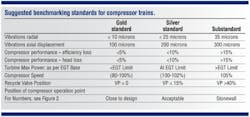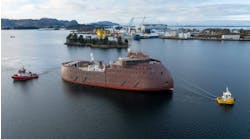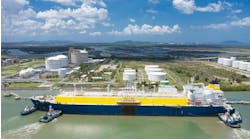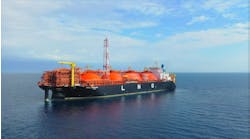FPSO, LNG carrier designs emerge to meet challenges
Nick Terdre
Contributing Editor
D2M is transferring its experience in the design of large ships and marine structures to floating liquid natural gas (FLNG) units. The French contractor, established 25 years ago by two naval architects with shipyard backgrounds, has developed designs for a range of FPSOs and LNG carriers, both of which are relevant to FLNG.
D2M can provide hydrodynamic calculations, using for example this hull model, for the design of FLNG vessels.
It can undertake the entire scope of the marine design of shipshape units for oil and gas production at sea, including naval architecture, structural design, hydrodynamics, marine systems, risk analysis, and the mooring system.
"We are able to provide neutral, factual analysis to support customers' decisions," said Carole Pavaut, operations director.
D2M's participation in FLNG projects so far has been largely at the early stage of conceptual design, investigating the main vessel dimensions, the cargo and tank arrangement, the number of stools or structural load-bearing pieces required in the hull, and performing sensitivity analyses.
The company does no topsides design, although accurate information about the weights and layout of the topside structures is essential for the hull engineering, and in particular decisions on the number and capacities of the stools required and where they should be placed. This helps optimize hull balance and thereby reduce hull weight, significantly extending vessel lifetime. Integrating the containment system chosen for LNG storage, whether of the SPB or membrane type, is another challenge for the hull design.
The prevailing metocean conditions at the vessel's planned location are also critical, whether in a cyclonic area such as the waters off northwest Australia or a region such as West Africa with a mild climate, but subject to an almost permanent swell.
Taking into account the array of relevant factors, including the dynamic motions of the vessel, the relative motions when an LNG tanker is offloading, fatigue aspects, and weight-bearing considerations, some very complex calculations have to be made, according to Pavaut.
"Our job is to provide the best compromise, taking into account weight, safety, and operational constraints," she commented.
Compared with FPSOs, FLNGs represent a higher order of challenge for both design and construction. With liquefaction and cryogenic processes to be incorporated, more modules are required, and these tend to be larger and heavier than those typical on an FPSO due to the complexity of the gas treatment and liquefaction processes. Again, with large volumes of gas on board and a greater spread of high-pressure gas pipes and equipment, there are also tougher safety challenges and an associated risk of explosion.
The dimensions of an FLNG unit closely relate to its production and storage capacities. However, it will typically be significantly larger than an FPSO – or, to put it another way, a smaller FLNG unit will have similar dimensions to a larger FPSO, but a greater weight.
As an example, Pavaut cites Total'sPazflor FPSO which recently came into operation off Angola, with D2M involved in the hull design. This is a large unit, 325 m (1,066 ft) long and 61 m (200 ft) wide, with a topside weight of 45,000 metric tons (49,604 tons) and an overall hull steel weight of 58,000 metric tons (63,934 tons). In comparison, an FLNG unit with a length of 350 m (1,148 ft), a width of 65 m (213 ft) and a topside weight of 42,000 metric tons (46,297 tons) would have a hull steel weight of 87,000 metric tons (95,901 tons). However, other units which are the subject of current FLNG projects may be much larger, presenting for example a length of 480 m (1,575 ft) and a width of 74 m (243 ft).
One reason why an FLNG tends to be much longer than an FPSO is the need to place modules with a risk of explosion as far as possible from the living quarters. For the same reason, the gap between modules has to be greater – typically 15-20 m (49-65 ft) – than on an FPSO (5 m/16 ft or less).
The choice of offloading system is another key in the hull design. This may be side-by-side, in which the tanker takes position alongside the FLNG unit and LNG transfer is affected by a rigid arm system, or tandem loading, with LNG transfer over the stern to the receiving vessel. The choice has an impact on the design of the hull, creating asymmetry in the distribution of topside weights and layout, and needs to be known at an early stage.
The constructability of the unit also has to be taken into account – every shipyard has its limitations and the larger the dimensions of the vessel, the smaller the number of yards capable of building it, which clearly has cost implications.
D2M has been involved in the design of more than 10 FPSOs currently operating off West Africa. In recent years, as some companies have opted to extend the operating life or the capabilities of their units rather than build new ones, D2M has also been commissioned to engineer upgrades, gaining further operational experience which can be incorporated into its design work.
Offshore Articles Archives
View Oil and Gas Articles on PennEnergy.com




